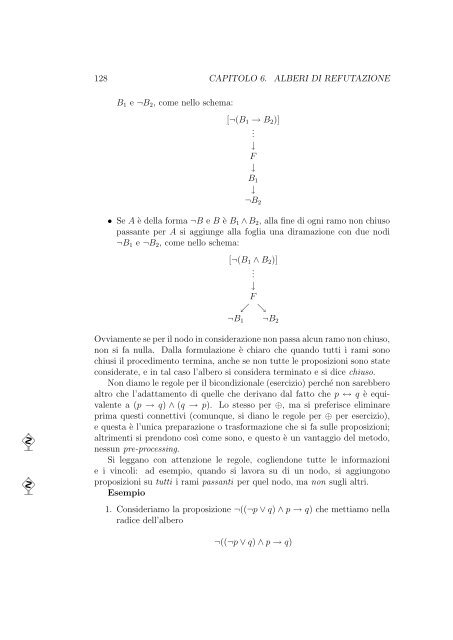Logica Matematica Corso di Laurea in Informatica ... - Mbox.dmi.unict.it
Logica Matematica Corso di Laurea in Informatica ... - Mbox.dmi.unict.it
Logica Matematica Corso di Laurea in Informatica ... - Mbox.dmi.unict.it
You also want an ePaper? Increase the reach of your titles
YUMPU automatically turns print PDFs into web optimized ePapers that Google loves.
128 CAPITOLO 6. ALBERI DI REFUTAZIONE<br />
B1 e ¬B2, come nello schema:<br />
[¬(B1 → B2)]<br />
.<br />
↓<br />
F<br />
↓<br />
B1<br />
↓<br />
¬B2<br />
• Se A è della forma ¬B e B è B1 ∧ B2, alla f<strong>in</strong>e <strong>di</strong> ogni ramo non chiuso<br />
passante per A si aggiunge alla foglia una <strong>di</strong>ramazione con due no<strong>di</strong><br />
¬B1 e ¬B2, come nello schema:<br />
[¬(B1 ∧ B2)]<br />
¬B1<br />
.<br />
↓<br />
F<br />
↙ ↘<br />
¬B2<br />
Ovviamente se per il nodo <strong>in</strong> considerazione non passa alcun ramo non chiuso,<br />
non si fa nulla. Dalla formulazione è chiaro che quando tutti i rami sono<br />
chiusi il proce<strong>di</strong>mento term<strong>in</strong>a, anche se non tutte le proposizioni sono state<br />
considerate, e <strong>in</strong> tal caso l’albero si considera term<strong>in</strong>ato e si <strong>di</strong>ce chiuso.<br />
Non <strong>di</strong>amo le regole per il bicon<strong>di</strong>zionale (esercizio) perché non sarebbero<br />
altro che l’adattamento <strong>di</strong> quelle che derivano dal fatto che p ↔ q è equivalente<br />
a (p → q) ∧ (q → p). Lo stesso per ⊕, ma si preferisce elim<strong>in</strong>are<br />
prima questi connettivi (comunque, si <strong>di</strong>ano le regole per ⊕ per esercizio),<br />
e questa è l’unica preparazione o trasformazione che si fa sulle proposizioni;<br />
altrimenti si prendono così come sono, e questo è un vantaggio del metodo,<br />
nessun pre-process<strong>in</strong>g.<br />
Si leggano con attenzione le regole, cogliendone tutte le <strong>in</strong>formazioni<br />
e i v<strong>in</strong>coli: ad esempio, quando si lavora su <strong>di</strong> un nodo, si aggiungono<br />
proposizioni su tutti i rami passanti per quel nodo, ma non sugli altri.<br />
Esempio<br />
1. Consideriamo la proposizione ¬((¬p ∨ q) ∧ p → q) che mettiamo nella<br />
ra<strong>di</strong>ce dell’albero<br />
¬((¬p ∨ q) ∧ p → q)




![Introduzione ai sistemi Wiki [PDF] - Mbox.dmi.unict.it](https://img.yumpu.com/16413205/1/184x260/introduzione-ai-sistemi-wiki-pdf-mboxdmiunictit.jpg?quality=85)











